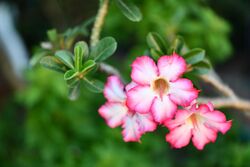Biology:Adenium
| Adenium | |
|---|---|

| |
| Adenium obesum | |
| Scientific classification | |
| Kingdom: | Plantae |
| Clade: | Tracheophytes |
| Clade: | Angiosperms |
| Clade: | Eudicots |
| Clade: | Asterids |
| Order: | Gentianales |
| Family: | Apocynaceae |
| Subfamily: | Apocynoideae |
| Tribe: | Nerieae |
| Genus: | Adenium Roem. & Schult.[1] |
| Synonyms[2] | |
| |
Adenium is a genus of flowering plants in the family Apocynaceae first described as a genus in 1819. It is native to Africa and the Arabian Peninsula.[3]
Cultivation and uses
Adenium obesum is grown as a houseplant in temperate and tropical regions. Numerous hybrids have been developed. Adeniums are appreciated for their colorful flowers and unusual thick caudices. They can be grown for many years in a pot and are commonly used for bonsai.

Because seed-grown plants are not genetically identical to the mother plant, desirable varieties are commonly propagated by grafting. Genetically identical plants can also be propagated by cutting. Cutting-grown plants do not tend to develop a desirable thick caudex as quickly as seed-grown plants.
The sap of Adenium boehmianum, A. multiflorum, and A. obesum contains toxic cardiac glycosides and is used as arrow poison throughout Africa for hunting large game.[4]
Classification
The genus Adenium has been held to contain as many as twelve species. These are considered by other authors to be subspecies or varieties. A late-20th-century classification by Plazier recognizes five species.[5]
- Species[3]
- Adenium arabicum Balf.f. = Adenium obesum
- Adenium boehmianum Schinz - (Namibia, Angola)
- Adenium multiflorum Klotzsch. (Southern Africa, from Zambia south)
- Adenium obesum (Forssk.) Roem. & Schult. - widespread from Senegal to Somalia, and also Arabian Peninsula
- Adenium oleifolium Stapf - South Africa, Botswana, Namibia
- Adenium swazicum Stapf (Eastern South Africa)[5][6]
- Formerly placed here
- Pachypodium namaquanum (Wyley ex Harv.) Welw. (as A. namaquanum Wyley ex Harv.)[6]
Common names
Adenium obesum is also known as the desert rose. In the Philippines , due to its resemblance to the related genus Plumeria, and the fact that it was introduced to the Philippines from Bangkok, Thailand, the plant is also called as Bangkok kalachuchi.[citation needed]
Due to its resemblance to a miniature frangipani tree and its popularity in bonsai, it is also sometimes known as Japanese frangipani.
References
- ↑ "Genus: Adenium Roem. & Schult.". Germplasm Resources Information Network. United States Department of Agriculture. 2003-03-14. http://www.ars-grin.gov/cgi-bin/npgs/html/genus.pl?182.
- ↑ "World Checklist of Selected Plant Species". http://apps.kew.org/wcsp/synonomy.do?name_id=3018.
- ↑ 3.0 3.1 Kew World Checklist of Selected Plant Families
- ↑ Schmelzer, G.H.; A. Gurib-Fakim (2008). Medicinal Plants. Plant Resources of Tropical Africa. pp. 43–49. ISBN 978-90-5782-204-9. https://books.google.com/books?id=7FJqgQ3_tnUC.
- ↑ 5.0 5.1 Stoffel Petrus Bester (June 2004). "Adenium multiflorum Klotzsch". South African National Biodiversity Institute's plant information website. http://www.plantzafrica.com/plantab/adeniummultiflor.htm.
- ↑ 6.0 6.1 "GRIN Species Records of Adenium". Germplasm Resources Information Network. United States Department of Agriculture. http://www.ars-grin.gov/cgi-bin/npgs/html/splist.pl?182.
Wikidata ☰ Q913594 entry
 |



